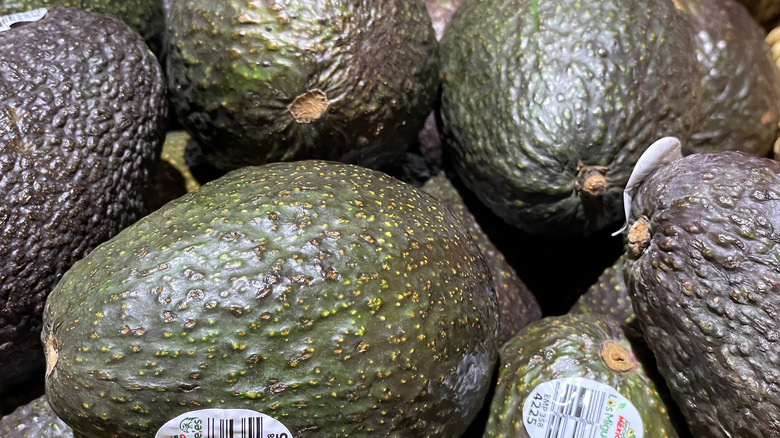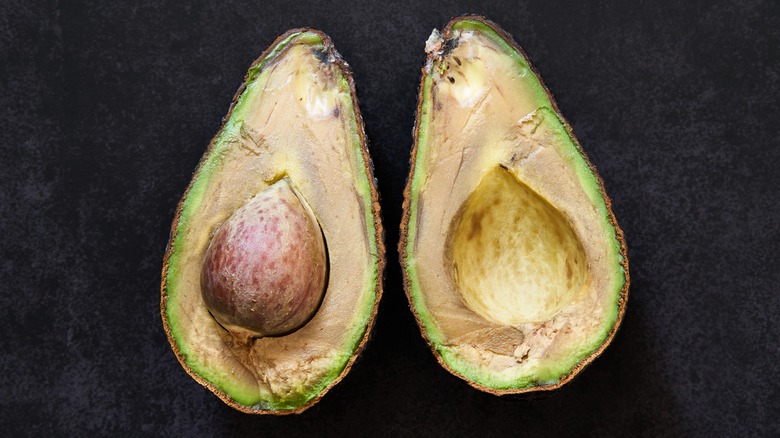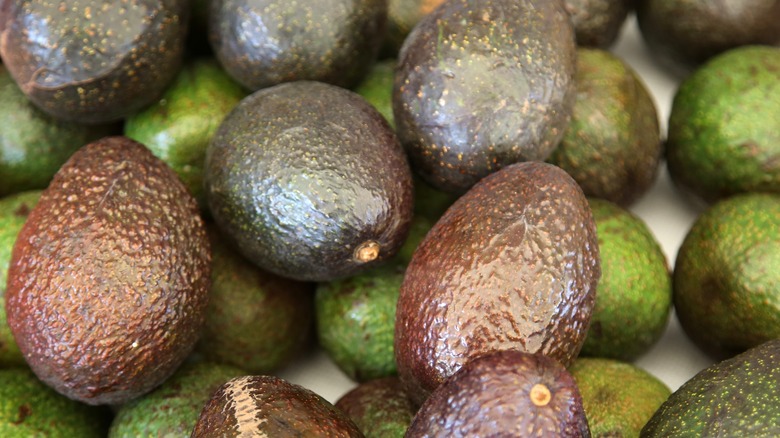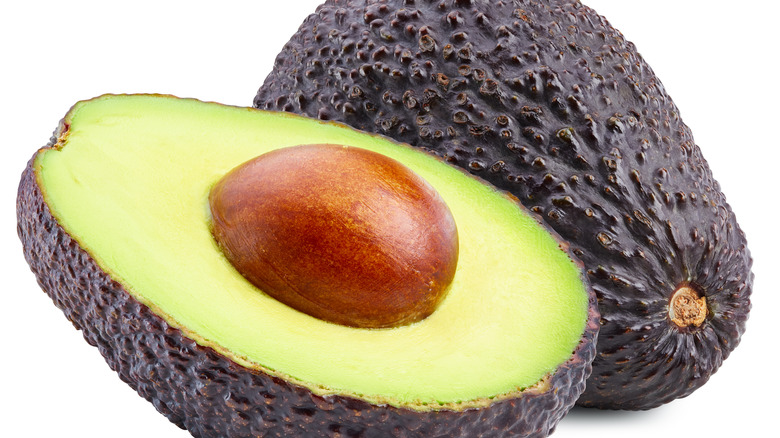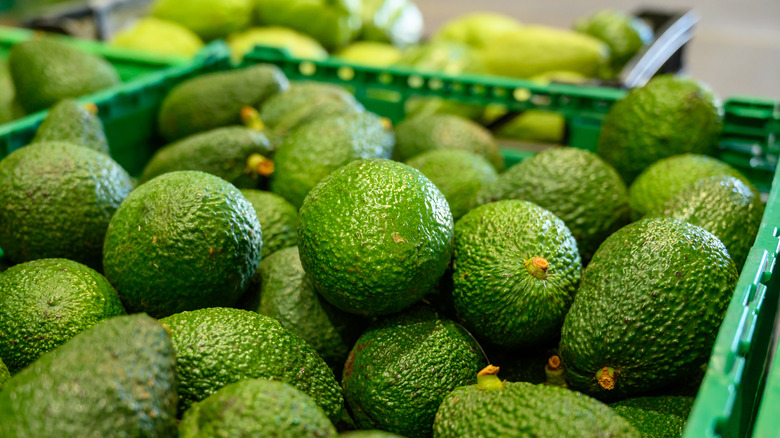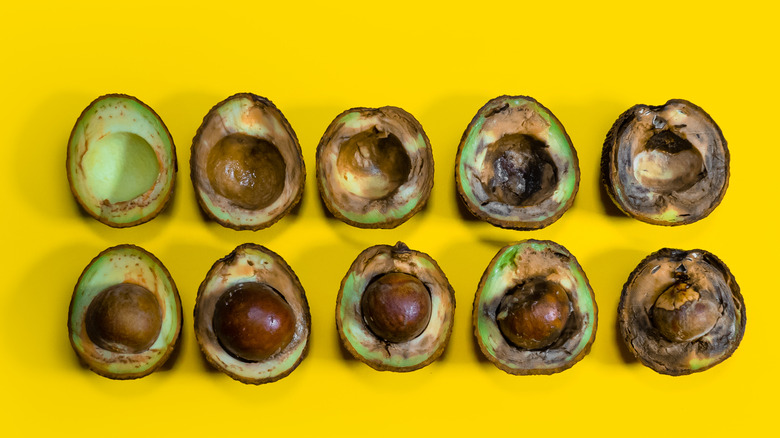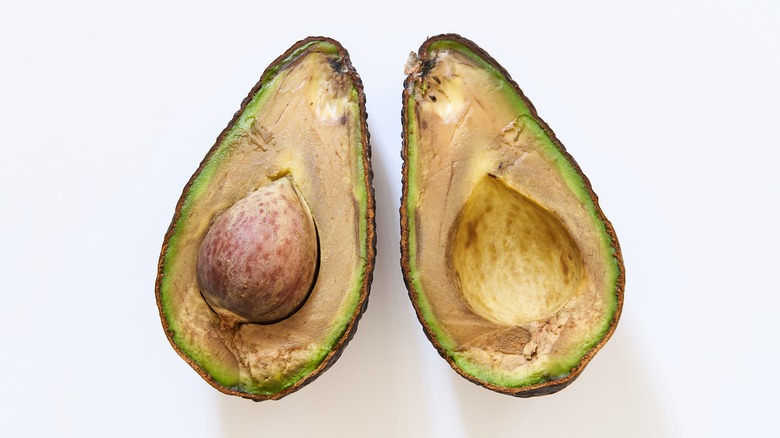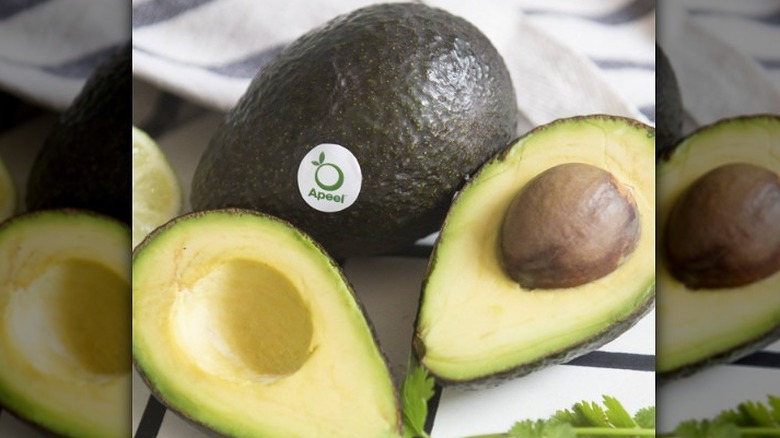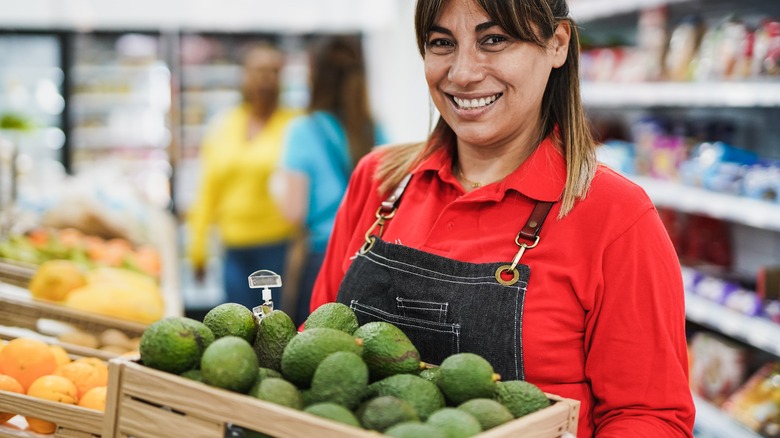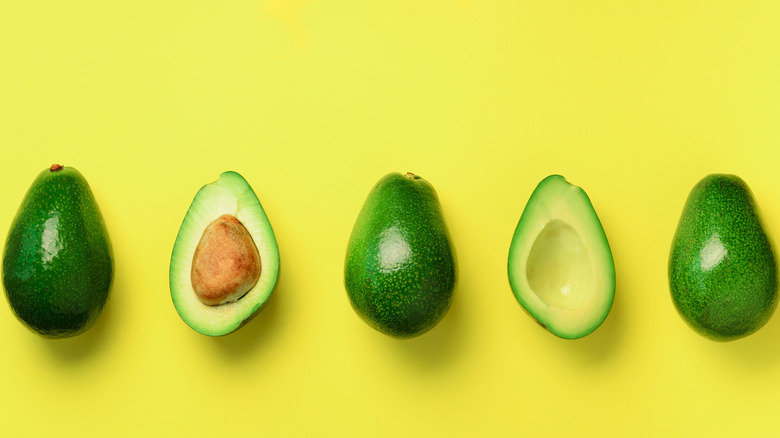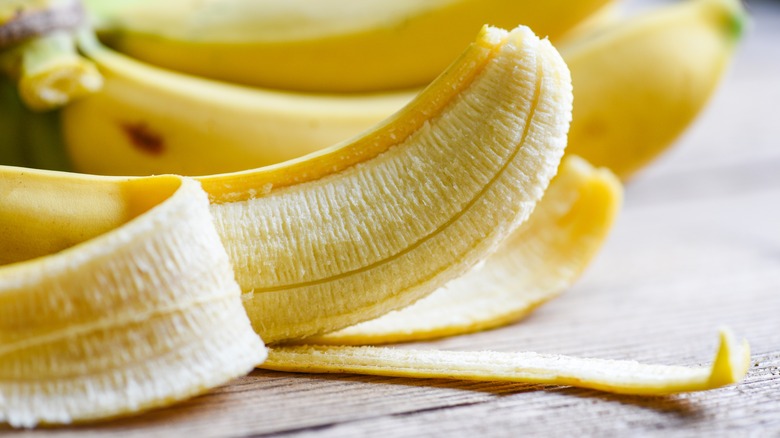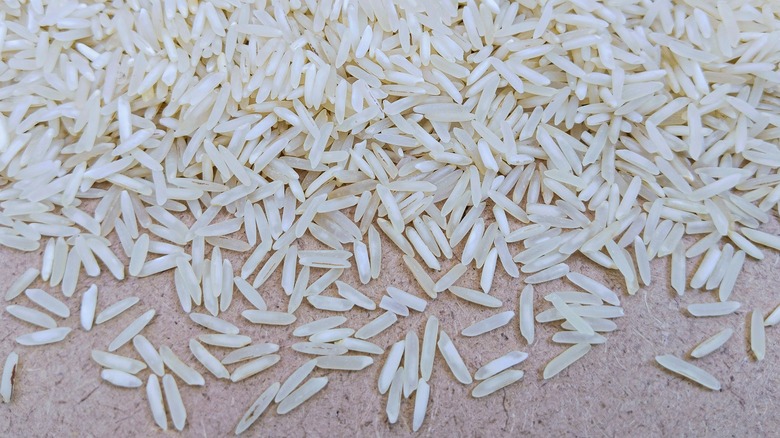13 Best Tips For Picking And Buying Avocados
Oh, for the love of avocados! It's funny how one of the world's most popular fruits is often mistaken for a vegetable. Could it be the green color that brings to mind leafy foods? Or its creamy grass-like taste, which doesn't exactly scream veggie? Whatever the culprit, avocados are a gift from mother nature. Their distinct flavor profile makes them extremely versatile, which lets them code-switch depending on a recipe's requirements. These unique fruits can be enjoyed as an oil, spread, dipped, or raw, and also could easily be mistaken for dinosaur eggs.
Their taste and health-boosting qualities will definitely have you eating an avocado every day if you don't already. Beyond their wide range of uses, they are also awesome sources of unsaturated fats, antioxidants, and lowering potential heart disease. You know the old saying, "An apple a day will keep the doctor away?" Well ... what they should've said instead was avocado. Its long list of qualities should convince you to join the avo-lution if you haven't already.
Learn the varying degrees of ripeness
Knowing how to tell whether or not your produce is ripe is an essential skill to have. It not only saves time and money, but it also infuses recipes with a richer flavor. Once upon a time, before nearly every whim was at the tip of our fingers, spotting signs of ripeness was a more common skill. Of course, that was before convenience replaced simple survival know-how. That said, in the hustle and bustle of our everyday lives, the appeal of convenience is completely understandable.
While there are many varieties, we'll use Haas avocados as an example since they're the most widely available. When picking Haas avocados, start with color. Underripe ones are usually bright to medium green, while almost ripe avocados tend to be a darker green color with scattered black spots. Each of these will be firm to the touch, although almost ripe avocados usually give a bit under pressure.
Knowing what signs to avoid comes in handy when picking the best produce. To spot perfectly ripe Haas, look for very dark green to dark brown and even eggplant purple shades of color. They'll give with a squeeze but aren't overly soft and mushy. And lastly, if you happen to be making same-day guacamole, over-ripened avocados are the darkest of the bunch; they're often worse for wear, with a mushy consistency. After you've picked your ripe Haas avocados, you should try out this crave-worthy guacamole recipe pronto!
A darker color doesn't always indicate ripeness
Sometimes using color to identify ripeness isn't the best approach. There's a lot the outside of an avocado can tell you, and indicators of ripeness will appear different depending on the variety. There are hundreds of avocado types; some even come in other colors and have their own deliciously distinct taste. According to the California Avocado Commission, some varieties retain their vibrant green skin when they become ripe. Of the types you'll find at the grocery store, California-grown Pinkerton and Zutano avocados are examples, along with the Florida-grown Pryor variety.
Some avocados even turn red when ripe, which is another reason the color doesn't always tell the full story. Make sure to check your local grocery store's avocado selection to see what types are available. Do a quick Google on the type to learn what specific ripeness signs to look for. Many Whole Foods locations place a cute sign next to their avocados that lets customers know if the avocados are ready to enjoy or need some days. Don't be shy; put those hands to work and pick some ripe and ready avocados.
Ripe avocado skin has a bumpy texture
Choosing pleasantly ripe avocados is a tactile endeavor, requiring touch and careful consideration. Their skin is the most immediately noticeable quality; it almost looks reptile-like yet pops with an eye-catching vivid green. While unripe avocados tend to be smoother, one sign that avocados are ripe is when they've developed bumpy textured skin. With that said, there is one caveat: too much bumpiness is a sign of over-ripeness.
If the avocado has bumpy skin, yet you're still unsure, other factors come into play, like how soft to touch it is and how dark of a green tint it has. If it easily yields under pressure, kindly place it back in a pile to avoid any bumpy rides ahead. After you've got the hang of it and mastered picking perfectly ripe avocados, think about saving the skin rather than tossing it away. By some reports, consuming avocado skin can enhance your skin's youthful sheen and may even kill cancerous cells due to high contents of the anti-toxin persin. As a healthy source of nutrients for your inside and outside, it's clear that avocados are a must-add to your diet.
The flesh should be firm but not solid
While avocados are round and reminiscent of stress balls, we definitely don't recommend you use any to squeeze your worries away. Nevertheless, squeezing is an essential part of the avocado ripe test ... gently, that is. After you've chosen one with a darker green hue and bumpy textured skin, the next step is to check for firmness. As you can imagine, rock-solid avocados make excellent skipping stones but are far from edible. Perfectly ripe avocados should yield slightly when pressure is applied, but if your fingers easily puncture the skin, that means that the avocado's overripe.
Naturally, it all depends on your specific avocado needs. Underripe avos are just fine if you don't plan to eat them right away, though they may be hard to cut through and won't yield that creamy texture you're likely aiming for. Give it some time. On the other hand, overripe ones are great if you're craving an avocado blueberry smoothie. Take it from us; knowing how to spot ripe avocados will definitely convince you to eat a whole lot more of them.
Pick from the bottom of the avocado pile
You might have an "oh, duh" moment after finding out that ripe avocado can be found at the bottom of the pile. It's all thanks to a fun chemical reaction that happens between produce and ethylene gas. Ethylene is a gas that fruits and vegetables naturally release as they undergo the ripening process. For example, unripe avocados generally carry low levels of ethylene, while overripe ones produce the most. Commercial manufacturers often expose their produce to ethylene on purpose to make them ripen faster.
The reason why avocados at the bottom ripen quickly is that they're exposed to ethylene gas from the entire avocado bunch. When squeezed between piles of avocados, all simultaneously getting their ripe on, of course, the effects are multiplied. Understandably, we, too, fear the risk of digging through a pile, dislodging a particularly placed one, and causing a massive wave of avocados to fall. As embarrassing as that could be, the best treasure is often buried and waiting for you to find it.
Make sure your avocados have stems
Your current futility in finding perfectly ripe avocados may stem from several things. Another surprising culprit just might be ... the stem. Fun fact: stems are the gatekeepers of flavor; they keep everything we love about fruit tucked inside nice and snuggly. When choosing your avocados, always make sure to buy avocados with the brown stem still attached. Stem-less avocados are exposed to air, which hastens the ripening process. If you grab an avocado without a stem, there's a good chance you might not like what you see after you slice it in two.
The stem is akin to the freshness seal found on any number of food products at grocery stores. Would we eat a can of Sour Cream & Onion Pringles that we found already opened? Well ... yeah, maybe, but that might be the only exception. At any rate, you get the gist: Stem equals green light, and no stem equals red light.
Once your avocados make it safely home, when you're ready to eat them, another indicator of ripeness lies beneath the stem. You must first remove the stem to check if it's green underneath, which lets you know it's ready to eat. If it's brown, put it down. Whereas if it doesn't come loose, it probably means the avocado is underripe.
Check avocados for any signs of mold
Mold has a shaky relationship with food; in rare cases, it contributes to the flavor profile, but it's a culinary boogie monster for most eats. In other words, mold has a voracious appetite you might not enjoy mixing with your own and a clear red flag that lets you know your avocado has gone bad. From mishandling to bruising, along with plain ol' expired shelf life, there are several reasons why an avocado can attract mold.
So long as the skin remains intact, the avocados' deliciousness remains protected. When damaged, punctures can cause air exposure, making them ripen faster while increasing the chances of mold growth. Mold can grow on the outside skin or contaminate the inside too. Fortunately, external growth is clearly visible, appearing as a grayish-white blotch of fuzz. Internal mold growth is more challenging to predict, yet you can take a good guess by looking for some of these indicators.
Dark blemishes can be a sign of over-ripening
Learning how to spot indicators of ripeness in avocados is like taking a crash course in the color green. From different shades and textures to an almost endless array of varieties, Pantone could devote an entire category to just avocado colors. While these veggie-like fruits are no stranger to a bruise or bump here and there, dark blemishes are never a good sign.
Even as avocados undergo color changes, the shifts usually appear like a gradient, smoothly transitioning to the next phase. When there are spots of discoloration, it may indicate mold or an over-ripe avo. Blemishes can also develop when an unripe avocado is exposed to cold temperatures. While dark spots aren't always a sign of old avos, if visual appeal sits high on your list of priorities, we recommend avoiding them altogether. Once you're feeling more confident about your picking skills, playing a little avocado roulette is okay.
Use Apeel's RipeFinder produce scanner
Yes, folks, knowing how to pick ripe avocados is a challenge many of us face. Your hands may not sweat nervously when entering the produce section, but the disappointment of picking an underripe avo is clearly something we've experienced as a collective. In fact, a startup called Apeel decided to make finding a solution their main prerogative. Hoping to reduce food waste, Apeel created the RipeFinder, a food scanner that identifies ripe avocados using advanced imaging technology combined with machine learning. Their fancy tech was made to protect supply chains and help customers make more informed decisions, and save time when they go grocery shopping.
Donning a look similar to a barcode scanner, Apeel's RipeFinder was made to help you pick the best avocados. Helping you skip the guessing games, it scans the fruit, translating the information it receives into simple prompts like "Your avocado is ready for your salad" or "Your avocado will be ready in four to five days." Unfortunately, your days of unripe avocados will have to last longer, as Apeel's RipeFinder is still in its testing stage. The company's larger goal extends beyond avocados to include all produce. Before you know it, picking unripe produce on accident will become a thing of the past.
Try different avocado varieties
While Haas avocados make up a staggering 80% of the world's avocado consumption, there are hundreds of varieties. So many, in fact, you'd still find it hard to try each one within a single lifetime. Avocados are primarily grown in Central and South America, along with smaller percentages coming from other continents. Mexico alone accounts for 45% of worldwide avocado production. CITATION According to Statista, our culinary cousin across the border harvested nearly 2.4 million tons of avos in 2021 alone.
With so many varieties of avocados, why not try all of the options your grocery store offers? Coming from Mexico, you'll find Haas, the world's most popular. At the same time, California is known for its Reed, Gwen, Zutano, Pinkerton, Fuerte, and Bacon avocados, to name a few. A visit to South Africa offers the experience of Maluma Haas, Ettinger, Ryan, and more. While a trip down under will let you taste Shepard avocados. As mentioned, trying them all will probably take an entire lifetime, but we think it's worth it.
Choose ripeness according to your eating schedule
All this talk about picking perfectly ripe avocados, and we forgot to mention the upside to unripe ones. If you have a busy schedule or want to enjoy avocados throughout the week, the ripening process can be a great thing. Choosing ripeness based on your schedule ensures a delicious experience whenever you're ready. When purchasing a batch, picking only ripe ones may result in food waste. It's because avocados continue to ripen, increasing the chances of them going bad before you can eat them.
A better approach is to pick avocados at various stages of ripeness. It's ok to grab a ripe and ready one if you plan on using it the same day, but if a few days will pass before you get around to it, it's wiser to include a few under-ripened ones. Even super firm avos are smart for future eats; there are a few tricks to quicken the ripening process. When you need your avo fix, choosing according to your eating schedule will also save you from making additional trips to the grocery store.
Store unripe avocados with bananas
Picking ripe avocados is sometimes a battle you cannot win; whatever your grocery store has available is the only option. If you end up walking out of the store with rock-solid unripe avos, there are some ways to speed up the ripening process. One surefire approach is storing your unripe avocados along with a banana in a paper bag. As we touched on earlier, produce releases a natural gas called ethylene as it ripens. The banana trick increases the avocados' exposure to the gas and causes the process to kick into high gear within the confines of the paper bag.
The goal is to ensure the paper bag is folded and sealed loosely yet securely. Your avos should have softened in anticipation of rapid consumption in only two to three days. If you want the process to move even faster, you can include an additional banana or another fruit type. Of course, the longer it's stored, the riper your avocados will become.
Ripen avocados with rice
Another method of making your avocados ripe quick, fast, and in a jiffy is by burying them in rice. CITATION Much like produce, uncooked rice contains loads of ethylene gas, which helps push the process along. It usually only takes a few days for it to take full effect and varies depending on the level of ripeness. While this isn't the first recommended approach, it will get the job done just as well.
Simply grab the bowl size you need, pour until the rice grains nearly reach the top, add your avocados, then secure it with a lid to trap in the ethylene. While the rice works its magic, enjoy the ripe produce you purchased. Keeping tabs over a handful of days, your avocados should be ready to add to your favorite recipe quickly. Sharing this fun ripening tip with your friends can also gain some good karma points.
